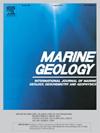自公元1906年以来,菲律宾La Union的海平面上升,地震间变形和El Niño的珊瑚微环礁记录
IF 2.2
3区 地球科学
Q2 GEOSCIENCES, MULTIDISCIPLINARY
引用次数: 0
摘要
吕宋岛西部相对海平面(RSL)受气候变化、构造变形和El Niño-Southern涛动的影响。长期、高分辨率的过去海平面和陆地水平变化记录对于预测未来的RSL或识别构造危险至关重要。珊瑚微环礁是重建RSL的宝贵替代品,但它们的解释依赖于对珊瑚骨架中记录的短期和长期变化的理解。我们使用垂直截面的x射线分析了菲律宾La Union Balaoan的Porites微环礁1906年至2018年的生长带。微环礁的表面形态、年带状带和生长历史显示,RSL在其一生中呈上升趋势,其间有17次衰减。珊瑚凋零通常与该地点附近的低潮同时发生,通常是由El Niño事件造成的。除去被侵蚀的部分,自1918年以来11次最强的厄尔尼诺Niños中有10次出现了减弱。同样,排除珊瑚倾斜引起的衰减,12个保存下来的振幅超过3毫米的衰减中有10个发生在强厄尔尼诺Niños期间。1948年至2018年,RSL以1.3±1.8 mm/年(2σ)的速度上升。通过比较卫星测高数据的海平面速率和珊瑚的RSL,我们估计1995年至2018年期间陆地垂直运动为−0.1±12.1毫米/年。巴罗安的指示意义是指当地水位与珊瑚微环礁最近一次消亡前的最高生长水平之间的关系,估计在最低天文潮以上31.5±10.0 cm (2σ)。本文章由计算机程序翻译,如有差异,请以英文原文为准。
A coral microatoll record of sea-level rise, interseismic deformation, and El Niño in La Union, Philippines since 1906 CE
Relative sea level (RSL) along western Luzon is influenced by climate change, tectonic deformation, and the El Niño–Southern Oscillation. Long, high-resolution records of past changes in sea level and land level are crucial to distinguish these contributions for forecasting future RSL or identifying tectonic hazards. Coral microatolls are invaluable proxies for reconstructing RSL, but their interpretation relies on understanding how short- and long-term changes are recorded in the coral skeleton. We analyzed growth bands from 1906 to 2018 CE of a Porites microatoll from Balaoan, La Union, Philippines, using X-rays of vertical cross sections. The microatoll's surface morphology, annual banding, and growth history reveal RSL rise during its lifetime punctuated by 17 diedowns. Coral diedowns generally coincide with low water near the site, often resulting from El Niño events. Excluding eroded sections, 10 of the 11 strongest El Niños since 1918 produced a diedown. Similarly, excluding a diedown caused by the coral tilting, 10 of the 12 preserved diedowns exceeding 3 mm in amplitude occurred during strong El Niños. Between 1948 and 2018 CE, RSL rose at 1.3 ± 1.8 mm/yr (2σ). Comparing sea-level rates from satellite altimetry and RSL from the coral, we estimate vertical land motion at −0.1 ± 12.1 mm/yr between 1995 and 2018 CE. The indicative meaning at Balaoan, defined as the relationship between local water levels and the highest level of growth of a coral microatoll before its most recent diedown, is estimated at 31.5 ± 10.0 cm (2σ) above lowest astronomical tide.
求助全文
通过发布文献求助,成功后即可免费获取论文全文。
去求助
来源期刊

Marine Geology
地学-地球科学综合
CiteScore
6.10
自引率
6.90%
发文量
175
审稿时长
21.9 weeks
期刊介绍:
Marine Geology is the premier international journal on marine geological processes in the broadest sense. We seek papers that are comprehensive, interdisciplinary and synthetic that will be lasting contributions to the field. Although most papers are based on regional studies, they must demonstrate new findings of international significance. We accept papers on subjects as diverse as seafloor hydrothermal systems, beach dynamics, early diagenesis, microbiological studies in sediments, palaeoclimate studies and geophysical studies of the seabed. We encourage papers that address emerging new fields, for example the influence of anthropogenic processes on coastal/marine geology and coastal/marine geoarchaeology. We insist that the papers are concerned with the marine realm and that they deal with geology: with rocks, sediments, and physical and chemical processes affecting them. Papers should address scientific hypotheses: highly descriptive data compilations or papers that deal only with marine management and risk assessment should be submitted to other journals. Papers on laboratory or modelling studies must demonstrate direct relevance to marine processes or deposits. The primary criteria for acceptance of papers is that the science is of high quality, novel, significant, and of broad international interest.
 求助内容:
求助内容: 应助结果提醒方式:
应助结果提醒方式:


